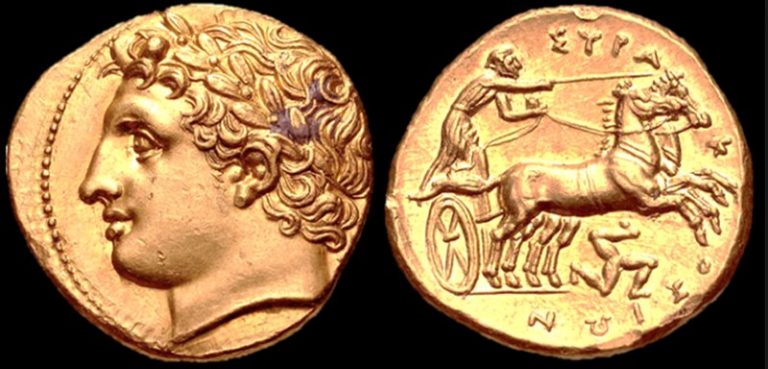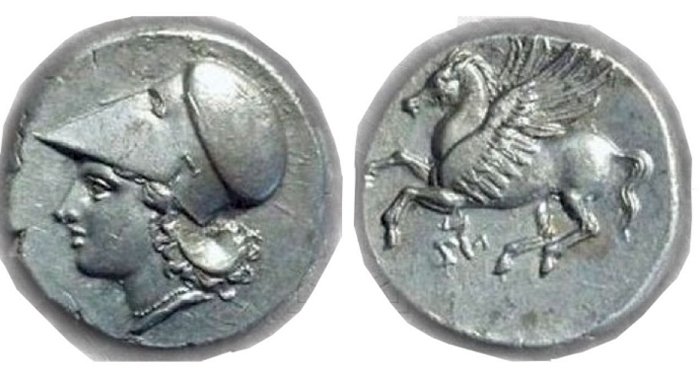The Sicilian ruler who upheld and extended Sicily’s independence, Agathocles of Syracuse, was a serial murderer.

From humble beginnings rose a man who many throughout history have called a tyrant. Agathocles’ birth is not recorded but his father was a humble potter and Agathocles learned that trade as well.
His father moved to Syracuse in about 343 BC but that would be long after Agathocles’ birth as in 333 BC, the son married. He chose the widow of his patron, Damas, to be his bride.

Litra of silver struck by Agathocles then tyrant of Syracuse (317-294 AC), representing at right a head of Athena and at the back a Pegasus with, under the belly, the triskeles which refers to Agathocles. source
Agathocles’ early life was not a peaceful one as he was never satisfied with the oligarchical rule that governed Syracuse. He led two unsuccessful rebellions that ended up with him being banned from the city.
Agathocles Could Never Be Trusted
In Agathocles’ return to Syracuse in 317 BC, he was at the head of an army. His advance on the city and eventual success at overthrowing the current rulers was based on a promise that he would observe and support democratic processes.
He did not and when the time was right, he killed roughly 10,000 of the Syracuse citizens to make sure he had complete and total control over the city and its people. After this treachery, Agathocles spent the next few years gaining control over different Greek cities in Sicily.
Once he had conquered these cities, Agathocles was placed in direct opposition to the rulers of Carthage. From 311 on to 309 BC, Agathocles waged war against the Carthaginians.
In one battle, he made an ally of Ophellas of Cyrenaica. The latter ruler recruited a strong army and after a 2 month march was able to join Agathocles and the two armies camped side by side.
Unfortunately, this was an error in judgment on the part of Ophellas as Agathocles attacked his ally, killing him in the battle. With Ophellas out of the way, Agathocles took possession of Ophellas’ army.

Military Encounter With Carthaginians
Reinforced by the assumption of his ally’s army, Agathocles was able to turn the war against Carthage in his favor. He did this by taking part of his army past a Carthaginian blockade and landed in Carthage’s territory in approx. 310 BC.
Agathocles’ Carthaginian enemy was Hamilcar (c. 275–228 BC), a general and statesman, leader of the Barcid family, and father of Hannibal, who heard about what was happening in his homeland so he sent about 5,000 troops home to fight off Agathocles’ advances.
Dekadrachm – 50 Litrai, Philippeios type, 317-311, Agathokles, Syracuse. source
But Hamilcar made an error in military judgement with this move.
Agathocles learned of the troop movement and was waiting for the Carthaginian forces when they landed. A short battle and Agathocles’ enemy was destroyed. Then with the lack of men in Sicily, Agathocles’ brother Antander defeated Hamilcar and captured him.
Hamilcar did not survive the torture inflicted upon him by Antander. The sea power of the Carthaginians was the only factor that stopped Agathocles from conquering Carthage itself. But with rebellion by different Greek cities on Sicily, Agathocles was forced to return to protect his territory.
Fighting On Sicily
Once he returned to his home country, Agathocles was able to take part of the northwest section of Sicily and put it under his control. But the Greek cities had gained power while he was a way and they defeated Agathocles in battle.
Despite commuting between Carthage and Sicily, Agathocles could not sustain his advantage and the Carthaginians were able to defeat his son in battle. Troops started to defect, so Agathocles left Carthage forever abandoning his army and his son to their fate. His son was killed by his own men, who sued for peace with the people of Carthage.
Facing two enemies back in Sicily was not a smart military move, so Agathocles tried to make peace. The Greek cities declined the offer to their regret. Once Agathocles made peace with the Carthaginians, he was able to use his very inferior but experienced force to defeat – the leaders of those Greek cities.
Agathocles became the ruler of Sicily once again in 306 BC.
The Controversy Surrounding His Death
History does not record the exact causes of Agathocles’ death. Some people say he was poisoned while others claim that he died of natural causes. What is sure is that as Agathocles got older, he suffered from ill health.
As he grew closer to death, Agathocles restored the old Syracusan democracy and stopped his sons from succeeding him as king